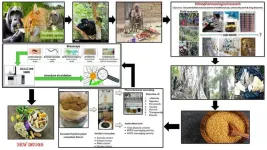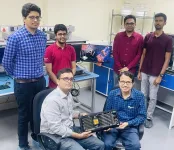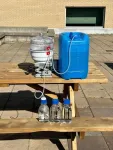(Press-News.org) COLUMBUS, Ohio – Mold can survive the harshest of environments, so to stop harmful spores from growing on future space stations, a new study suggests a novel way to prevent its spread.
Researchers created a predictive approach for modeling unintended microbial growth in critical spaces and applied it to life on the International Space Station.
An analysis of dust samples obtained from the space station found that repeated elevated humidity exposures for even a short time can lead to rapid microbial growth and composition changes in dust that make it easier for microbes, such as fungi, to thrive.
The study provides important insight into how healthy environments might be maintained during future missions, especially as the commercial space industry begins to prompt more people to live and work above Earth, said Karen Dannemiller, senior author of the study and an associate professor of civil, environmental and geodetic engineering and environmental health sciences at The Ohio State University.
“It’s really important to understand the exposures that happen in the space environment in part because we see immune system changes in astronauts,” she said. “People who are normally healthy individuals may be especially vulnerable to microbes in space, more so than on Earth.”
The study was published today in the journal Microbiome.
Historically, many spacecraft have had issues with unintended microbial growth because, much like a typical home on Earth, they, too, are environments that tend to trap the moisture humans emit. On the ISS, dust is usually produced by people as they go about their daily activities, but left unchecked, these floating particles can cause a range of negative health issues for the crew, such as asthma or allergies, and degrade building materials and equipment.
To ensure that dust levels aboard the ISS are carefully controlled, every week astronauts must clean the protective screens that cover the filters of the space station’s air ventilation system. In this study, four separate vacuum bag samples of the dust collected from these housekeeping chores were sent down to Dannemiller’s team to be tested.
After incubating the samples for two weeks at different relative humidities to simulate a scenario where an unexpected event, such as a temporary air ventilation system failure, could cause bursts of moisture, analysis revealed that fungi and bacteria can grow in the same concentrated amounts as dust collected from residential homes on the ground.
“Spacecraft actually aren’t that different from what we see on Earth in terms of having a unique indoor microbiome,” said Nicholas Nastasi, lead author of the study and a postdoctoral researcher at Ohio State’s Indoor Environmental Quality Laboratory. “If you put people in a space, there will always be microbes there, so it’s important to prevent their spread because once it starts, it’s often not too easy to get rid of.”
Spacecraft are especially prone to microbial growth because they are enclosed environments where humans constantly exhale moisture. If that moisture builds up, mold can begin to grow, as seen in past space stations such as Mir. Although the ISS has much improved controls for moisture, unexpected situations can still easily occur, said Nastasi.
Additionally, while Earth and space environments are complex in their own unique ways, the two more often than not contain similar core microbial communities, Nastasi said. Moreover, staying knowledgeable about the evolution of these communities will make certain that vulnerable individuals both on- and off-world have the information needed to maintain a healthy indoor microbiome on the space station.
“In designing some of our current space station systems, we’ve already learned a lot of really important lessons in terms of how to keep moisture under control,” said Dannemiller. “Now we’re learning even more that we can use to advance these systems in the future.”
In general, the study also suggests that the team’s research could later aid the development of planetary protection protocols aimed at preventing contamination of Earth or any other celestial bodies humans may visit.
Next, the team will likely work to discover what effect other untested spaceflight variables, such as microgravity, radiation and elevated carbon dioxide levels, have on microbial growth in similar working space stations, like NASA’s lunar station Gateway or other imminent commercial projects. Many of their upcoming projects will also benefit from Ohio State’s terrestrial analog of the George Washington Carver Science Park, a replica of Starlab space station science park that will allow researchers to conduct parallel missions on the ground.
“There’s a lot of other unique spaceflight factors we can potentially add to these microbial models to make them more accurate and useful,” said Nastasi. “We’ll keep refining what we do to maintain those healthy space environments and having unprecedented access to a platform such as Starlab will help immensely.”
This study was supported by NASA. Other Ohio State co-authors were Ashleigh Bope, Marit E. Meyer and John M. Horack.
#
Contact: Karen Dannemiller, Dannemiller.70@osu.edu
Written by: Tatyana Woodall, Woodall.52@osu.edu
END
Pisa, 11 september. It is the first magnetically controlled prosthetic hand, that allows amputees to reproduce all movements simply by thinking and to control the force applied when grasping fragile objects. No wires, no electrical connection, only magnets and muscles to control the movements of the fingers and enable everyday activities such as opening a jar, using a screwdriver, picking up a coin.
A research team from the BioRobotics Institute of the Scuola Superiore Sant'Anna in Pisa, coordinated by Prof. Christian Cipriani, has ...
Four plants consumed by wild gorillas in Gabon and used by local communities in traditional medicine show antibacterial and antioxidant properties, find Leresche Even Doneilly Oyaba Yinda from the Interdisciplinary Medical Research Center of Franceville in Gabon and colleagues in a new study publishing September 11 in the open-access journal PLOS ONE.
Wild great apes often consume medicinal plants that can treat their ailments. The same plants are often used by local people in traditional medicine.
To investigate, researchers observed the behavior of western lowland gorillas (Gorilla gorilla ...
Survey data collected from Chicago, Illinois at the time of the 2020 police shooting of Jacob Blake in nearby Wisconsin shows that trust in police plummeted among Black residents after the shooting. Jonathan Ben-Menachem and Gerard Torrats-Espinosa of Columbia University in New York, U.S., present these findings in the open-access journal PLOS ONE on September 11, 2024.
For young minority men in the U.S., police violence has become a leading cause of death. Prior research has explored how police violence and misconduct might reduce trust in police, but most studies have been limited in ...
Quitting cigarettes can significantly lower a person’s risk of atrial fibrillation (AFib) compared to those who continue to smoke, according to a study published today in JACC: Clinical Electrophysiology. The findings show that the benefits of quitting start right away, suggesting that it is possible to reverse the risk of negative health outcomes.
“The findings provide a compelling new reason to show current smokers that it’s not too late to quit and that having smoked in the past doesn’t ...
Atrial fibrillation, a rapid, irregular heart beat that can lead to stroke or sudden death, is three times more common than previously thought, affecting nearly 5% of the population, or 10.5 million U.S. adults, according to new estimates from UC San Francisco.
A-Fib, as the condition is commonly known, has been on the rise for at least the past decade, driven by the aging of the population, along with increasing rates of hypertension, diabetes and obesity. Earlier projections had estimated that 3.3 million U.S. adults ...
Summary: The U.S. National Science Foundation (NSF) Daniel K. Inouye Solar Telescope, the world’s most powerful solar telescope, operated by the NSF National Solar Observatory (NSO), achieved a major breakthrough in solar physics by successfully producing its first detailed maps of the Sun’s coronal magnetic fields. This milestone, led by NSO Associate Astronomer Dr. Tom Schad, was recently published in Science Advances, and promises to enhance our understanding of the Sun's atmosphere and how its changing conditions lead to impacts on Earth's technology-dependent society. The corona, or the Sun’s ...
In a landmark study published today in Science Advances, Dr. Shai Bel and his research team at the Azrieli Faculty of Medicine of Bar-Ilan University have uncovered crucial insights into how antibiotic use increases the risk of inflammatory bowel disease (IBD).
The study demonstrates that antibiotics interfere with the protective mucus layer in the intestine, a discovery that could reshape our understanding of antibiotic effects and IBD development.
IBD, which includes Crohn’s disease and ulcerative colitis, affects approximately 1% of the global population. This debilitating condition is ...
In a landmark advancement, researchers at the Indian Institute of Science (IISc) have developed a brain-inspired analog computing platform capable of storing and processing data in an astonishing 16,500 conductance states within a molecular film. Published today in the journal Nature, this breakthrough represents a huge step forward over traditional digital computers in which data storage and processing are limited to just two states.
Such a platform could potentially bring complex AI tasks, like training Large Language Models (LLMs), to ...
Regions of the genome associated with Alzheimer’s disease and dementia in African populations will be presented at the Future of Dementia in Africa conference on September 11-12, 2024. The studies highlight discrepancies compared to Caucasian populations and underscore that a lack of diversity in genomic studies potentially limits the effectiveness of targeted therapies across diverse populations.
The Future of Dementia in Africa conference will take place at the J.W. Marriott Hotel in Nairobi, Kenya. It is a Nature Conference, ...
Researchers at the University of Waterloo have designed an energy-efficient device that produces drinking water from seawater using an evaporation process driven largely by the sun.
Desalination is critical for many coastal and island nations to provide access to fresh water, given water scarcity concerns due to rapid population growth and increasing global water consumption. Roughly 2.2 billion people worldwide have no access to clean water, emphasizing the urgent need for new technologies to generate fresh water, according to the UN World Water Development Report 2024.
Current desalination systems pump seawater through membranes to ...






